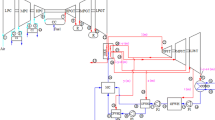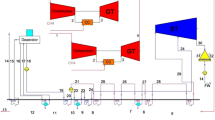Abstract
This paper presents a methodology based on graph theoretic approach (GTA) to design a new gas turbine power plant (GTPP), upgrading of existing plant and evaluation of two real life operating gas turbine power plants. Different combinations may be recommended by a manufacturer to an organization for selecting or improving the thermal efficiency of a power plant. This paper recognizes various design parameters affecting the gas turbine power plant efficiency. All these parameters are interacting with each other by different amounts. An attempt has been made to develop a mathematical model of GTPP from these interacting parameters using GTA. A GTPP efficiency index is proposed which assesses the influence power of these parameters.








Similar content being viewed by others
References
Ashley DS, Zubaidy SA (2011) Gas turbine performance at varying ambient temperature. Appl Therm Eng 31:2735–2739
Attri R, Dev N, Sharma V (2013) Graph theoretic approach (GTA)—a multi-attribute decision making (MADM) technique. Res J Eng Sci 2(1):50–53
Attri R, Grover S, Dev N (2014) A graph theoretic approach to evaluate the intensity of barriers in the implementation of total productive maintenance (TPM). Int J Prod Res 52(10):3032–3051
Bhargava R, Bianchi M, Peretto A, Spina PR (2004) A feasibility study of existing gas turbines for recuperated, intercooled and reheat cycle. ASME J Eng Gas Turbines Power 126:531–544
Bianchi M, Negri di Montenegro G, Peretto A (2005) Cogenerative below ambient gas turbine (BAGT) performance with variable thermal power. J Eng Gas Turbines Power 127:592–598
Bolland O, Stadaas JF (1995) Comparative evaluation of combined cycles and gas turbine systems with water injection, steam injection, and recuperation. J Eng Gas Turbines Power 117:138–145
Boyce MP (2002) Handbook for cogeneration and combined cycle power plants. ASME Press, New York
Chiesa P, Consonni S, Lozza G, Macchi E (1993) Predicting the ultimate performance of advanced power cycles based on very high temperature gas turbine engines. ASME Paper 93-GT-223
Deo N (2000) Graph theory with application to engineering and computer science. Prentice-Hall, New Delhi
Dev N, Attri R (2013) System modelling and analysis of a gas turbine power plant using graph theoretic approach. Int J Energy Environ Econ 21(1):21–33
Dev N, Samsher, Kachhwaha SS (2013a) System modeling and analysis of a combined cycle power plant. Int J Syst Assur Eng Manag 4(4):353–364
Dev N, Samsher, Kachhwaha SS, Attri R (2013b) Exergy analysis and simulation of a 30 MW cogeneration cycle. Front Mech Eng 8(2):169–180
Dev N, Goyal GK, Attri R, Kumar N (2013c) Graph theoretic analysis of advance combined cycle power plants alternatives with latest gas turbines. In: Proceedings of ASME 2013 Gas Turbine India conference, GTINDIA2013, December 5–6, 2013, Bangalore, Karnataka, India
Dev N, Samsher, Kachhwaha SS, Attri R (2013d) GTA-based framework for evaluating the role of design parameters in cogeneration cycle power plant efficiency. Ain Shams Eng J 4:273–284
Dev N, Attri R, Sharma V, Rana A (2013e) Development of graph theoretic model for economic analysis of combined heat and power system. Int J Manag Behav Sci 4:166–174
Dev N, Attri R, Sharma V, Kumar K (2013f) Economic analysis of a cogeneration cycle power plant. Int J Manag Behav Sci 4:184–189
Dev N, Samsher, Kachhwaha SS, Attri R (2014a) Development of reliability index for combined cycle power plant using graph theoretic approach. Ain Shams Eng J 5(1):193–203
Dev N, Samsher, Kachhwaha SS, Attri R (2014b) Development of reliability index for cogeneration cycle power plant using graph theoretic approach. Int J Syst Assur Eng Manag. doi:10.1007/s13198-014-0235-4
Dev N, Samsher, Kachhwaha SS, Attri R (2014c) GTA Modeling of combined cycle power plant efficiency analysis. Ain Shams Eng J. doi:10.1016/j.asej.2014.08.002
Faisal MN, Banwet DK, Shankar R (2007) Quantification of risk mitigation environment of supply chains using graph theory and matrix methods. Eur J Ind Eng 1(1):22–39
Jurkat WB, Ryser HJ (1966) Matrix factorization of determinants and permanents. J Algebra 3(1):1–27
Kulkarni S (2005) Graph theory and matrix approach for performance evaluation of TQM in Indian industries. TQM Mag 17(6):509–526
Lakshminarasimha AN, Boyce MP, Meher-Homji CB (1994) Modelling and analysis of gas turbine performance deterioration. ASME J Eng Gas Turbines Power 116(1):46–52
Najjar YSH (2000) Gas turbine cogeneration systems: a review of some novel cycles. Appl Therm Eng 20:179–197
Najjar YSH, Akyurt M (1994) Combined cycle with gas turbine engine. Heat Recovery Syst CHP 14:93–103
Poullikkas AL (2005) An overview of current and future sustainable gas turbine technologies. Renew Sustain Energy Rev 9:409–443
Raj T, Attri R (2010) Quantifying barriers to implementing total quality management (TQM). Eur J Ind Eng 4(3):308–335
Saravanamuttoo HIH, Rogers GFC, Cohen H (2003) Gas turbine theory. Pearson Education, Upper Saddle River
Singh O, Prasad BN (2008) Influence of different means of turbine blade cooling on the thermodynamic performance of combined cycle. Appl Therm Eng 28:2315–2326
Torbidoni L, Horlock JH (2006) Calculation of the expansion through a cooled gas turbine stage. J Turbomach 128:555–563
Upadhyay N, Aggarwal VP (2007) Structural modeling and analysis of intelligent mobile learning environment: a graph theoretic system approach. J Appl Quant Methods 2(2):226–248
Vogt RL (1992) Future trends in turboshaft engines up to the 5000 horse power class. J Eng Gas Turbines Power 114:797–801
Wani MF, Gandhi OP (1999) Development of maintainability index for mechanical systems. Reliab Eng Syst Saf 65:259–270
Wen H, Narula RG (2000) Economics of gas turbine inlet air cooling for combined cycle plants. In: Proceedings of American power conference, Chicago, USA, pp 100–105
Yokoyama R, Ito K (2006) Optimal design of gas turbine cogeneration plants in consideration of discreetness of equipment capabilities. J Eng Gas Turbine Power Trans ASME 128:336–343
Author information
Authors and Affiliations
Corresponding author
Rights and permissions
About this article
Cite this article
Dev, N., Attri, R.K. Evaluation of gas turbine power plant efficiency using graph theoretic approach. Int J Syst Assur Eng Manag 8 (Suppl 2), 676–689 (2017). https://doi.org/10.1007/s13198-016-0506-3
Received:
Revised:
Published:
Issue Date:
DOI: https://doi.org/10.1007/s13198-016-0506-3




